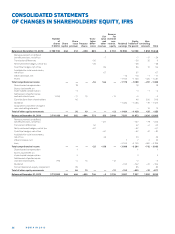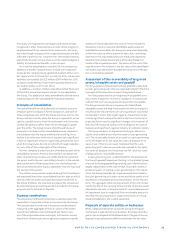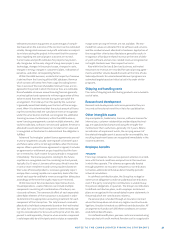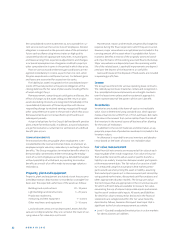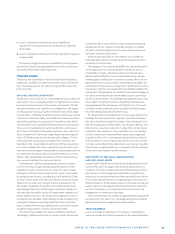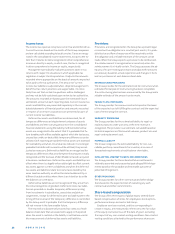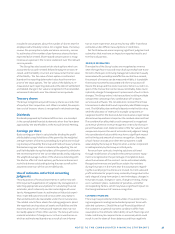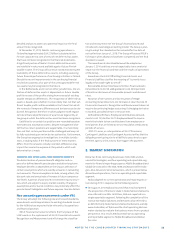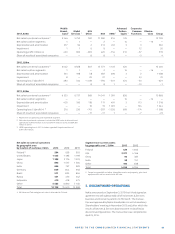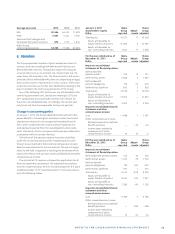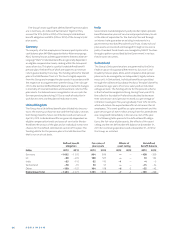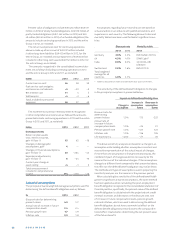Nokia 2013 Annual Report Download - page 38
Download and view the complete annual report
Please find page 38 of the 2013 Nokia annual report below. You can navigate through the pages in the report by either clicking on the pages listed below, or by using the keyword search tool below to find specific information within the annual report.NOKIA IN 2013
36
Income taxes
The income tax expense comprises current tax and deferred tax.
Current taxes are based on the results of the Group companies
and are calculated according to local tax rules. Taxes are recog-
nized in the consolidated income statements, except to the ex-
tent that it relates to items recognized in other comprehensive
income or directly in equity, in which case, the tax is recognized
in other comprehensive income or equity, respectively.
Management periodically evaluates positions taken in tax
returns with respect to situations in which applicable tax
regulation is subject to interpretation. It adjusts the amounts
recorded where appropriate on the basis of amounts expected
to be paid to the tax authorities. The amount of current
income tax liabilities is adjusted when, despite management’s
belief that tax return positions are supportable, it is more
likely than not that certain tax positions will be challenged
and may not be fully sustained upon review by tax authorities.
The amounts recorded are based upon the estimated future
settlement amount at each reporting date. Current income tax
assets and liabilities are presented separately in the consoli-
dated statements of fi nancial position and amounts recorded
in respect of uncertain tax positions are presented as part of
current income tax liabilities.
Deferred tax assets and liabilities are determined, for all
temporary diff erences arising between tax bases of assets
and liabilities and their carrying amounts in the consolidated
fi nancial statements using the liability method. Deferred tax
assets are recognized to the extent that it is probable that fu-
ture taxable profi t will be available against which the tax losses,
unused tax credits or deductible temporary diff erences can be
utilized. Each reporting period deferred tax assets are assessed
for realizability and when circumstances indicate it is no longer
probable that deferred tax assets will be utilized, they are ad-
justed as necessary. Deferred tax liabilities are recognized for
temporary diff erences that arise between the amounts initially
recognized and the tax base of identifi able net assets acquired
in business combinations. Deferred tax assets and liabilities are
off set when there is a legally enforceable right to off set current
tax assets against current tax liabilities and when the deferred
tax assets and liabilities relate to income taxes levied by the
same taxation authority on either the same taxable entity or
diff erent taxable entities where there is an intention to settle
the balances on a net basis.
Deferred tax liabilities are not recognized if they arise from
the initial recognition of goodwill. Deferred income tax liabili-
ties are provided on taxable temporary diff erences arising
from investments in subsidiaries, associates and joint ar-
rangements, except for deferred income tax liability where the
timing of the reversal of the temporary diff erence is controlled
by the Group and it is probable that the temporary diff erence
will not reverse in the foreseeable future.
The enacted or substantively enacted tax rates as of each
balance sheet date that are expected to apply in the period
when the asset is realized or the liability is settled are used in
the measurement of deferred tax assets and liabilities.
Provisions
Provisions are recognized when the Group has a present legal
or constructive obligation as a result of past events, it is prob-
able that an outfl ow of resources will be required to settle
the obligation and a reliable estimate of the amount can be
made. When the Group expects a provision to be reimbursed,
the reimbursement is recognized as an asset only when the
reimbursement is virtually certain. The Group assesses the ad-
equacy of its pre-existing provisions and adjusts the amounts
as necessary based on actual experience and changes in facts
and circumstances at each balance sheet date.
RESTRUCTURING PROVISIONS
The Group provides for the estimated cost to restructure when
a detailed formal plan of restructuring has been completed,
the restructuring plan has been announced by the Group and a
reliable estimate of the amount can be made.
PROJECT LOSS PROVISIONS
The Group provides for onerous contracts based on the lower
of the expected cost of fulfi lling the contract and the expected
cost of terminating the contract.
WARRANTY PROVISIONS
The Group provides for the estimated liability to repair or
replace products under warranty at the time revenue is
recognized. The provision is an estimate calculated based on
historical experience of the level of volumes, product mix and
repair and replacement cost.
MATERIAL LIABILITY
The Group recognizes the estimated liability for non-can-
cellable purchase commitments for inventory in excess of
forecasted requirements at each balance sheet date.
INTELLECTUAL PROPERTY RIGHTS (IPR) PROVISIONS
The Group provides for the estimated future settlements
related to asserted and unasserted past alleged IPR infringe-
ments based on the probable and estimable outcome of
potential infringement.
OTHER PROVISIONS
The Group provides for other contractual and other obliga-
tions based on the expected cost of executing any such
contractual and other commitments.
Share-based compensation
The Group off ers three types of global equity settled share-
based compensation schemes for employees: stock options,
performance shares and restricted shares.
Employee services received, and the corresponding in-
crease in equity, are measured by reference to the fair value
of the equity instruments as of the date of grant, excluding
the impact of any non-market vesting conditions. Non-market
vesting conditions attached to the performance shares are


